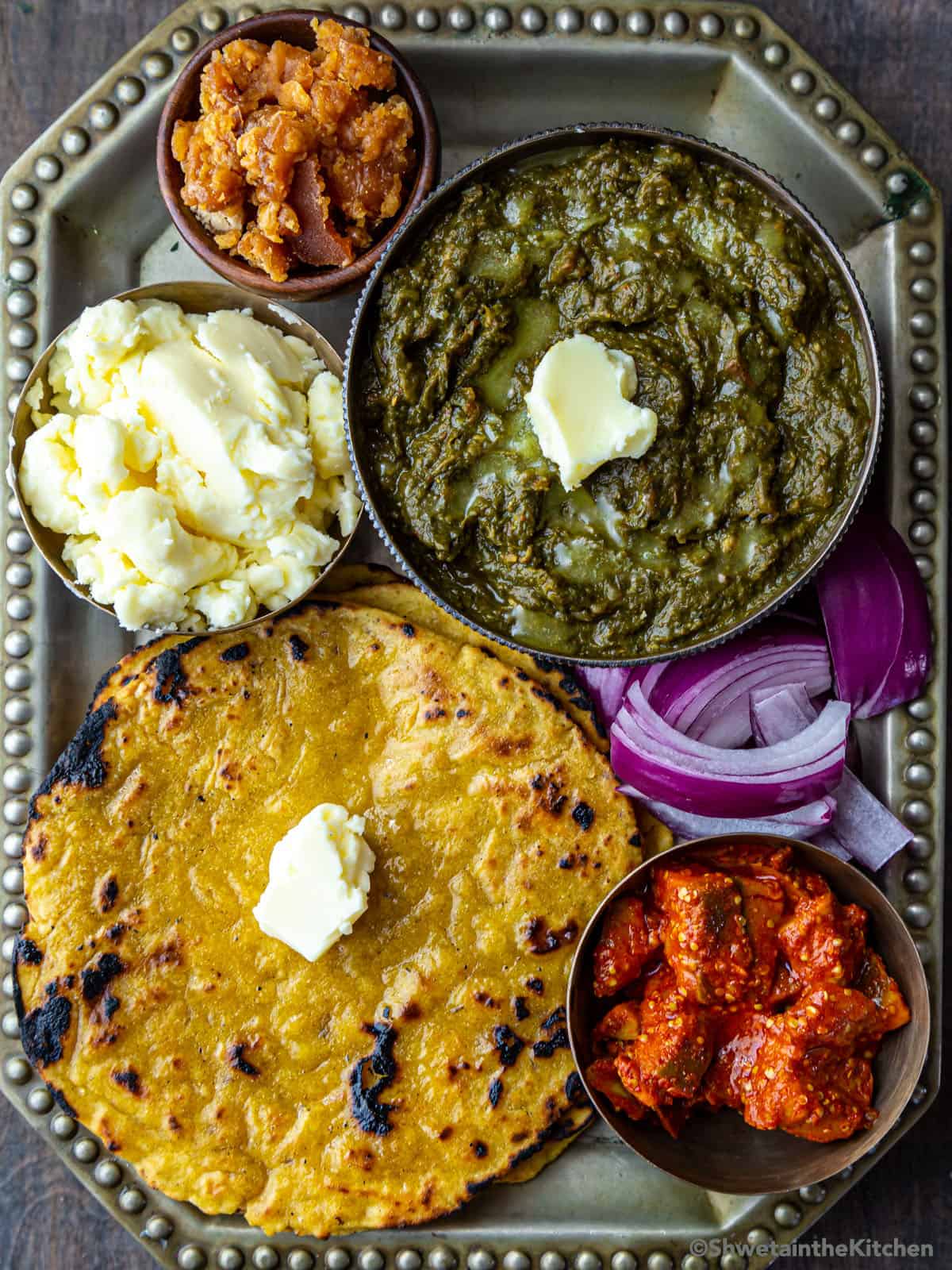Sarson ka Saag and Makki ki Roti: A Gastronomic Journey Through Punjab’s Winter Delicacy
Introduction
In the heartland of Punjab, amidst vast fields of mustard greens and corn, there exists a culinary masterpiece that warms the soul and delights the palate – Sarson ka Saag and Makki ki Roti. This iconic winter dish embodies the rich agricultural heritage of Punjab, combining earthy flavors with rustic charm to create a meal that is both comforting and deeply satisfying.

Origins and Cultural Significance
Sarson ka Saag and Makki ki Roti have deep roots in Punjab’s agrarian society. Traditionally eaten during the winter months when mustard greens (sarson) are in season, this dish not only celebrates the bounty of the land but also serves as a communal feast, bringing families and communities together around the warmth of a shared meal.
Ingredients and Preparation
1. Sarson ka Saag (Mustard Greens Curry)**
The preparation of Sarson ka Saag begins with cleaning and finely chopping mustard greens, along with spinach and sometimes fenugreek leaves (methi). These greens are then simmered until tender with ginger, garlic, green chilies, and spices such as cumin and coriander. The cooked greens are traditionally mashed with a wooden churner (madhani) to achieve a coarse texture that retains the essence of the fresh greens.
2. Makki ki Roti (Corn Flour Bread)**
Makki ki Roti is the perfect accompaniment to Sarson ka Saag. It is made from corn flour (makki ka atta), which gives it a distinct yellow color and a slightly grainy texture. The dough is kneaded with warm water and rolled out into flatbread, which is then cooked on a hot griddle until golden brown and crispy on the edges.
Serving and Accompaniments
Sarson ka Saag and Makki ki Roti are traditionally served hot, garnished with a dollop of homemade butter or ghee. They are often accompanied by a side of jaggery (gur) or pickled onions (kachumber) to balance the robust flavors of the dish. A glass of buttermilk (lassi) or a tall glass of chaas (spiced buttermilk) complements the meal perfectly, providing a refreshing contrast to the rich and hearty flavors.
Regional Variations and Adaptations
While the basic recipe for Sarson ka Saag and Makki ki Roti remains consistent across Punjab, there are regional variations that highlight local ingredients and preferences. For example, in some parts of Punjab, the saag may be cooked with a hint of cream or yogurt for added richness, while in others, it may be spiced more robustly with red chili powder or garam masala.
Health Benefits and Nutritional Value
Beyond its delicious taste, Sarson ka Saag and Makki ki Roti are packed with nutritional benefits. Mustard greens are rich in vitamins A, C, and K, as well as dietary fiber and antioxidants. Makki ki Roti, made from corn flour, is gluten-free and provides essential nutrients such as carbohydrates and protein. Together, they form a balanced meal that nourishes the body and provides energy during the cold winter months.
Cultural Significance and Festivals
Sarson ka Saag and Makki ki Roti hold a special place in Punjabi culture, especially during festivals like Lohri and Baisakhi. During these celebrations, families gather around bonfires, singing traditional folk songs and enjoying the warmth of the fire along with the hearty flavors of this beloved dish. It symbolizes prosperity, abundance, and the joy of community.
Cooking Tips and Techniques
Preparing Sarson ka Saag and Makki ki Roti requires patience and attention to detail. Achieving the right balance of flavors in the saag, ensuring the roti is cooked evenly on a hot griddle, and mastering the art of kneading the dough to the perfect consistency are all essential skills that contribute to the dish’s authenticity and taste.
Conclusion
In conclusion, Sarson ka Saag and Makki ki Roti are more than just a meal – they are a celebration of Punjab’s agricultural heritage, culinary prowess, and communal spirit. Whether enjoyed in a traditional village home or at a bustling restaurant in a city, this dish captures the essence of Punjab’s rich cultural tapestry and leaves a lasting impression on anyone fortunate enough to taste it.
Next time you find yourself craving a taste of Punjab’s flavors, consider immersing yourself in the culinary artistry of Sarson ka Saag and Makki ki Roti. From the fields to the kitchen table, this dish continues to weave stories of tradition, resilience, and the simple joy of sharing a meal with loved ones.
—
This comprehensive blog post explores the origins, preparation, cultural significance, health benefits, and cooking techniques of Sarson ka Saag and Makki ki Roti, offering readers a deep dive into why this dish holds such a special place in Punjabi cuisine and culture.







